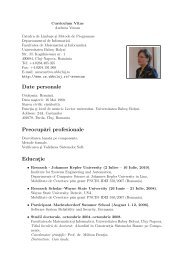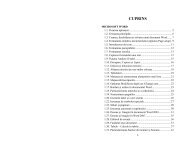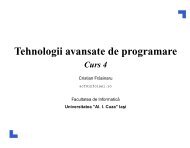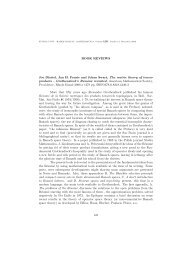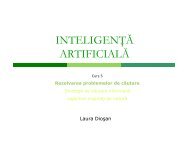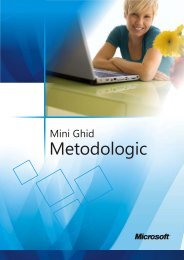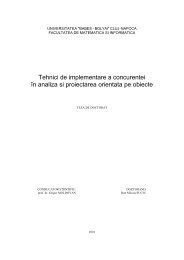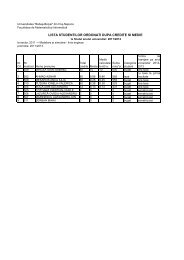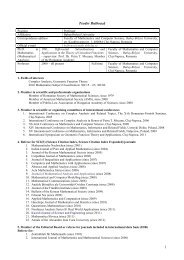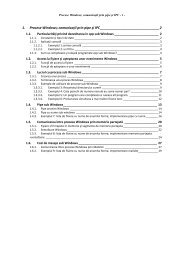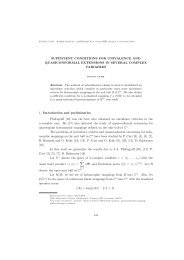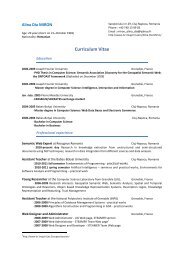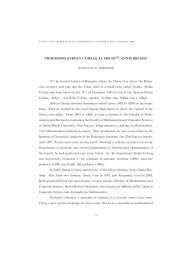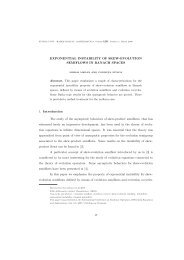CONTENTS
CONTENTS
CONTENTS
Create successful ePaper yourself
Turn your PDF publications into a flip-book with our unique Google optimized e-Paper software.
186 ISTVAN GERGELY CZIBULA<br />
The rest of the paper is structured as follows. A clustering approach for assisting<br />
developers in the process of tranforming software systems written in procedural programming<br />
languages into object-oriented systems is proposed in Section 2. Section 3<br />
contains some conclusions of the paper and also outlines further research directions.<br />
2. Our approach<br />
Let S = {s1, s2, ..., sn} be a non object-oriented software system, where si, 1 ≤<br />
i ≤ n can be a subprogram (function or procedure), a global variable, a user defined<br />
type.<br />
In the following we will refer an element s ∈ S as an entity.<br />
In order to transform S into an object-oriented system, we propose an approach<br />
consisting of two steps:<br />
• Data collection - The existent software system is analyzed in order to extract<br />
from it the relevant entities: subprograms, local and global variables,<br />
subprograms parameters, subprograms invocations, data types and modules,<br />
source files or other structures used for organizing the procedural code.<br />
• Grouping - The set of entities extracted at the previous step are grouped<br />
in clusters. The goal of this step is to obtain clusters corresponding to the<br />
application classes of the software system S.<br />
In the Grouping step we propose a k-medoids based clustering algorithm, kOOS<br />
(k-medoids for Transforming Software Sytems into Object-Oriented Software Systems).<br />
In our clustering approach, the objects to be clustered are the entities from the<br />
software system S, i.e., O = {s1, s2, . . . , sn}. Our focus is to group similar entities<br />
from S in order to obtain groups (clusters) that will represent classes in the equivalent<br />
object-oriented version of the software system S.<br />
In order to express the dissimilarity degree between the entities from the software<br />
system S, we will use an adapted generic cohesion measure [3]. Consequently, the<br />
distance d(si, sj) between two entities si and sj is expressed as in Equation (1).<br />
(1) d(si, sj) =<br />
<br />
1 − |p(si)∩p(sj)|<br />
|p(si)∪p(sj)| if p(si) ∩ p(sj) = ∅<br />
∞ otherwise<br />
where, for a given entity e ∈ S, p(e) defines a set of relevant properties of e, expressed<br />
as follows.<br />
• If e is a subprogram (procedure or function) then p(e) consists of: the subprogram<br />
itself, the source file or module where e is defined, the parameters<br />
types of e, the return type of e if it is a function and all subprograms that<br />
invoke e.<br />
• If e is global variable then p(e) consists of: the variable itself, the source files<br />
or modules where the variable is defined, all subprograms that use e.<br />
• If e is a user defined type then p(e) consists of: the type itself, all subprograms<br />
that use e, all subprograms that have a parameter of type e and all functions<br />
that have e as returned type.<br />
,



